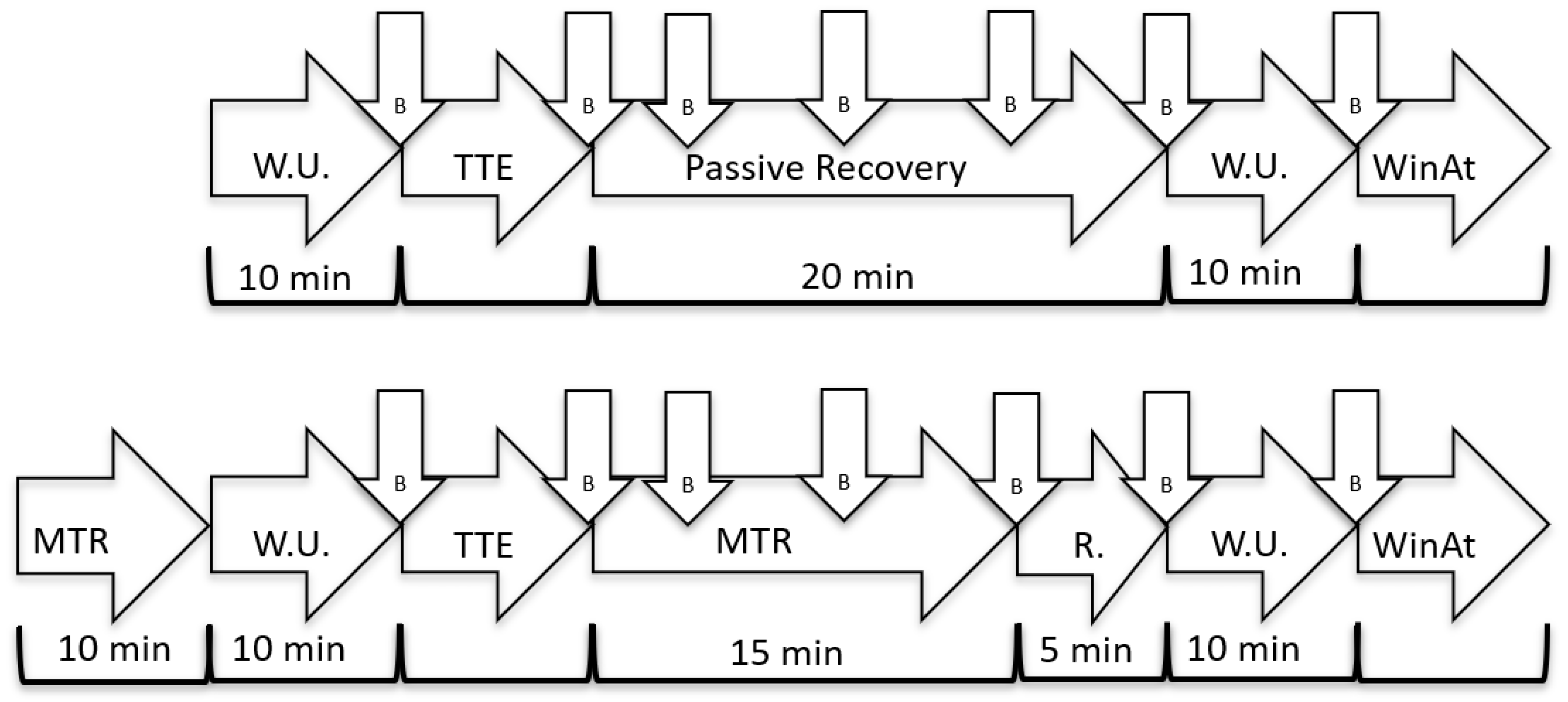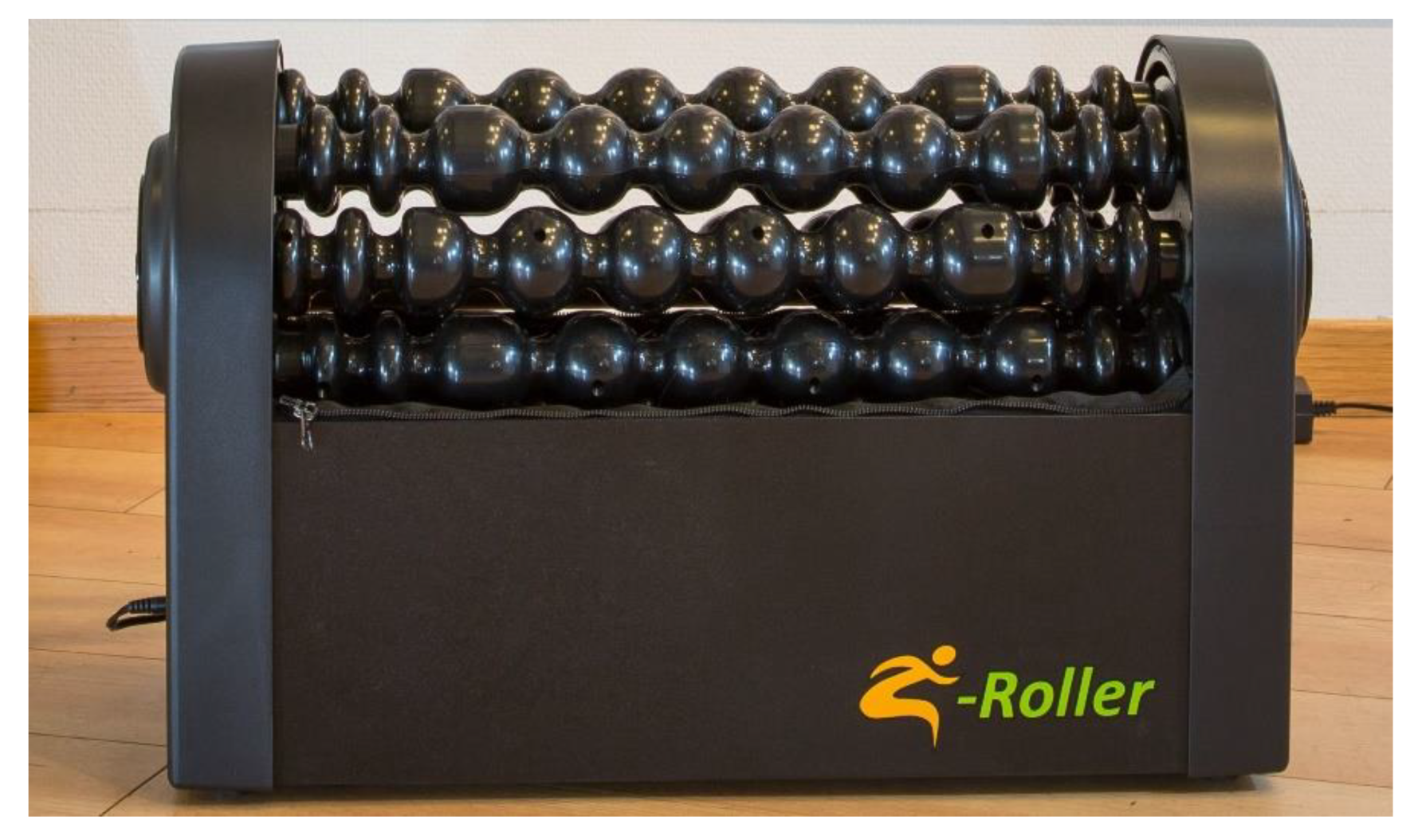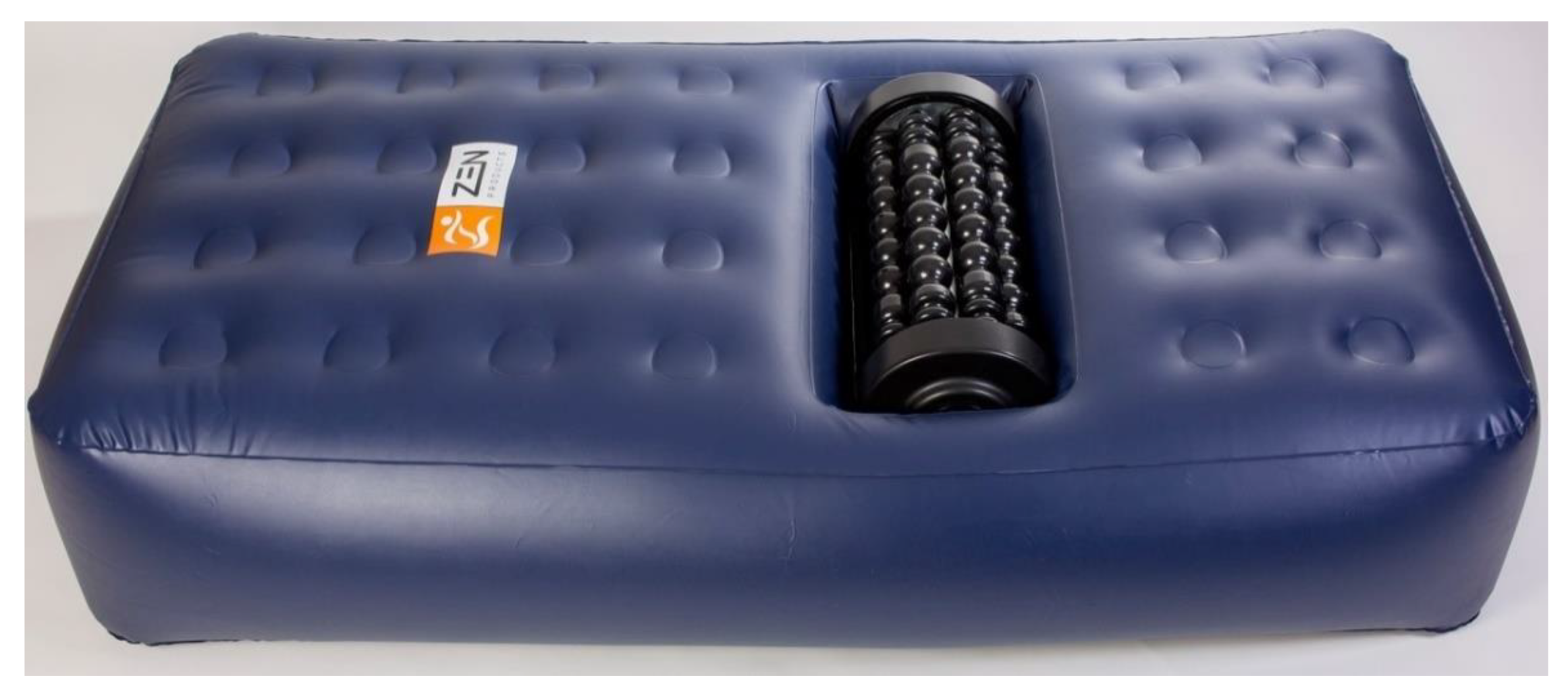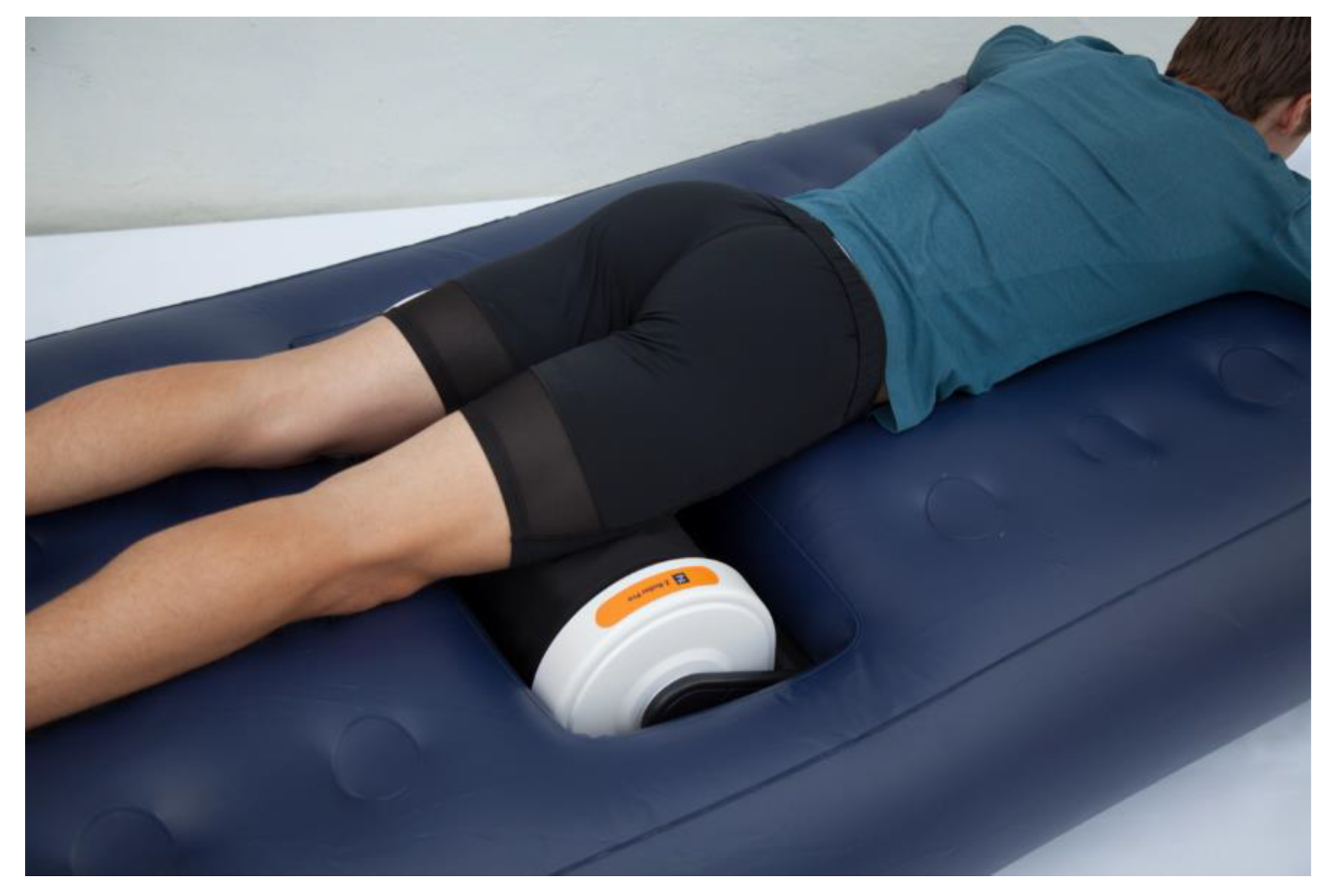Acute Effect of Quadriceps Myofascial Tissue Rolling Using A Mechanical Self-Myofascial Release Roller-Massager on Performance and Recovery in Young Elite Speed Skaters
Abstract
1. Introduction
2. Materials and Methods
2.1. Study Design and Participants
2.2. Participants
2.3. Procedure
2.3.1. Anthropometric Measurements and Warm-Up
2.3.2. Test to Exhaustion
2.3.3. Intervention
2.3.4. Wingate Anaerobic Cycle Ergometer Test
2.4. Statistical Analysis
3. Results
3.1. The Effect of Pre Exercise Myofascial Tissue Release on Performance to Exhaustion
3.2. The Effect of Myofascial Tissue Release on Blood Lactate Concentration between High Intensity Exercises
3.3. The Effect of Myofascial Tissue Release on the Consecutive High Intensity Exercise
4. Discussion
4.1. The Effect of Pre Exercise Myofascial Tissue Release on Performance to Exhaustion
4.2. The Myofascial Tissue Release Effect on Recovery and Consecutive Test of Anaerobic Capacity
4.3. Methodological Considerations
5. Conclusions
Author Contributions
Funding
Acknowledgments
Conflicts of Interest
References
- Bogdanis, G.C.; Nevill, M.E.; Boobis, L.H.; Lakomy, H.K.; Nevill, A.M. Recovery of power output and muscle metabolites following 30 s of maximal sprint cycling in man. J. Physiol. 1995, 482 Pt 2, 467–480. [Google Scholar] [CrossRef]
- Losnegard, T.; Andersen, M.; Spencer, M.; Hallén, J. Effects of active versus passive recovery in sprint cross-country skiing. Int. J. Sports Physiol. Perform. 2015, 10, 630–635. [Google Scholar] [CrossRef] [PubMed]
- Monedero, J.; Donne, B. Effect of recovery interventions on lactate removal and subsequent performance. Int. J. Sports Med. 2000, 21, 593–597. [Google Scholar] [CrossRef] [PubMed]
- Herda, T.J.; Cramer, J.T. Bioenergetics of Exercise and Training, in Essentials of Strength Training and Conditioning; Haff, G.G., Triplett, N.T., Eds.; Human Kinetics: Champaign, IL, USA, 2016; pp. 43–63. [Google Scholar]
- Cairns, S.P. Lactic acid and exercise performance: Culprit or friend? Sports Med. 2006, 36, 279–291. [Google Scholar] [CrossRef] [PubMed]
- Kraemer, W.J.; Marchitelli, L.; Gordon, S.E.; Harman, E.; Dziados, J.E.; Mello, R.; Frykman, P.; McCurry, D.; Fleck, S.J. Hormonal and growth factor responses to heavy resistance exercise protocols. J. Appl. Physiol. (1985) 1990, 69, 1442–1450. [Google Scholar] [CrossRef]
- D’Amico, A.; Paolone, V. The Effect of Foam Rolling on Recovery Between two Eight Hundred Metre Runs. J. Hum. Kinet. 2017, 57, 97–105. [Google Scholar] [CrossRef]
- Poppendieck, W.; Wegmann, M.; Ferrauti, A.; Kellmann, M.; Pfeiffer, M.; Meyer, T. Massage and Performance Recovery: A Meta-Analytical Review. Sports Med. 2016, 46, 183–204. [Google Scholar] [CrossRef]
- Menzies, P.; Menzies, C.; McIntyre, L.; Paterson, P.; Wilson, J.; Kemi, O.J. Blood lactate clearance during active recovery after an intense running bout depends on the intensity of the active recovery. J. Sports Sci. 2010, 28, 975–982. [Google Scholar] [CrossRef]
- Hohenauer, E.; Taeymans, J.; Baeyens, J.P.; Clarys, P.; Clijsen, R. The Effect of Post-Exercise Cryotherapy on Recovery Characteristics: A Systematic Review and Meta-Analysis. PLoS ONE 2015, 10, e0139028. [Google Scholar] [CrossRef]
- Versey, N.G.; Halson, S.L.; Dawson, B.T. Water immersion recovery for athletes: Effect on exercise performance and practical recommendations. Sports Med. 2013, 43, 1101–1130. [Google Scholar] [CrossRef]
- Branco, B.H.M.; Fukuda, D.H.; Andreato, L.V.; da Silva Santos, J.F.; Esteves, J.V.D.C.; Franchini, E. The Effects of Hyperbaric Oxygen Therapy on Post-Training Recovery in Jiu-Jitsu Athletes. PLoS ONE 2016, 11, e0150517. [Google Scholar] [CrossRef] [PubMed]
- Lundberg, T.R.; Howatson, G. Analgesic and anti-inflammatory drugs in sports: Implications for exercise performance and training adaptations. Scand. J. Med. Sci. Sports 2018, 28, 2252–2262. [Google Scholar] [CrossRef] [PubMed]
- Brown, F.; Gissane, C.; Howatson, G.; Van Someren, K.; Pedlar, C.; Hill, J. Compression Garments and Recovery from Exercise: A Meta-Analysis. Sports Med. 2017, 47, 2245–2267. [Google Scholar] [CrossRef] [PubMed]
- Sands, W.A.; McNeal, J.R.; Murray, S.R.; Ramsey, M.W.; Sato, K.; Mizuguchi, S.; Stone, M.H. Stretching and Its Effects on Recovery: A Review. Strength Cond. J. 2013, 35, 30–36. [Google Scholar] [CrossRef]
- D’Amico, A.P.; Gillis, J. The influence of foam rolling on recovery from exercise-induced muscle damage. J. Strength Cond. Res. 2017, 33, 2443–2452. [Google Scholar]
- Rey, E.; Padrón-Cabo, A.; Costa, P.B.; Barcala-Furelos, R. The Effects of Foam Rolling as a Recovery Tool in Professional Soccer Players. J. Strength Cond. Res. 2017, 33, 2194–2201. [Google Scholar] [CrossRef]
- Cheatham, S.W.; Kolber, M.J.; Cain, M.; Lee, M. The Effects Of Self-Myofascial Release Using A Foam Roll Or Roller Massager On Joint Range Of Motion, Muscle Recovery, And Performance: A Systematic Review. Int. J. Sports Phys. Ther. 2015, 10, 827–838. [Google Scholar]
- Behara, B.; Jacobson, B.H. Acute Effects of Deep Tissue Foam Rolling and Dynamic Stretching on Muscular Strength, Power, and Flexibility in Division I Linemen. J. Strength Cond. Res. 2017, 31, 888–892. [Google Scholar] [CrossRef]
- Bradbury-Squires, D.J.; Noftall, J.C.; Sullivan, K.M.; Behm, D.G.; Power, K.E.; Button, D.C. Roller-massager application to the quadriceps and knee-joint range of motion and neuromuscular efficiency during a lunge. J. Athl. Train. 2015, 50, 133–140. [Google Scholar] [CrossRef]
- Macdonald, G.Z.; Button, D.C.; Drinkwater, E.J.; Behm, D.G. Foam rolling as a recovery tool after an intense bout of physical activity. Med. Sci. Sports Exerc. 2014, 46, 131–142. [Google Scholar] [CrossRef]
- Healey, K.C.; Hatfield, D.L.; Blanpied, P.; Dorfman, L.R.; Riebe, D. The effects of myofascial release with foam rolling on performance. J. Strength Cond. Res. 2014, 28, 61–68. [Google Scholar] [CrossRef] [PubMed]
- Park, D.J.; Hwang, Y.I. A pilot study of balance performance benefit of myofascial release, with a tennis ball, in chronic stroke patients. J. Bodyw. Mov. Ther. 2016, 20, 98–103. [Google Scholar] [CrossRef] [PubMed]
- Mikesky, A.E.; Bahamonde, R.E.; Stanton, K.; Alvey, T.; Fitton, T. Acute effects of The Stick on strength, power, and flexibility. J. Strength Cond. Res. 2002, 16, 446–450. [Google Scholar] [PubMed]
- Sullivan, K.M.; Silvey, D.B.; Button, D.C.; Behm, D.G. Roller-massager application to the hamstrings increases sit-and-reach range of motion within five to ten seconds without performance impairments. Int. J. Sports Phys. Ther. 2013, 8, 228–236. [Google Scholar] [PubMed]
- International Skating Union. Special Regulations & Technical Rules—Speed Skating; International Skating Union: Lausanne, Switzerland, 2018. [Google Scholar]
- Foster, C.; Rundell, K.W.; Snyder, A.C.; Stray-Gundersen, J.; Kemkers, G.; Thometz, N.; Broker, J.; Knapp, E. Evidence for restricted muscle blood flow during speed skating. Med. Sci. Sports Exerc. 1999, 31, 1433–1440. [Google Scholar] [CrossRef] [PubMed]
- Rundell, K.W. Compromised oxygen uptake in speed skaters during treadmill in-line skating. Med. Sci. Sports Exerc. 1996, 28, 120–127. [Google Scholar] [CrossRef]
- Hofman, N.; Orie, J.; Hoozemans, M.J.; Foster, C.; de Koning, J.J. Wingate Test as a Strong Predictor of 1500-m Performance in Elite Speed Skaters. Int. J. Sports Physiol. Perform. 2017, 12, 1288–1292. [Google Scholar] [CrossRef]
- De Koning, J.J.; Foster, C.; Lampen, J.; Hettinga, F.; Bobbert, M.F. Experimental evaluation of the power balance model of speed skating. J. Appl. Physiol. (1985) 2005, 98, 227–233. [Google Scholar] [CrossRef]
- Borg, G.A. Physical Performance and Perceived Exertion; Gleerup: Lund, Sweden, 1962. [Google Scholar]
- Vyaire, M. Vyntus CPX Powered by SentrySuite. 2016. Available online: https://www.vyaire.com/Documents/international/brochures/respiratory-care/cardiopulmonary/RC_Vyntus-CPX_BR_EN.pdf (accessed on 10 December 2018).
- Garzon, M.; Gayda, M.; Nigam, A.; Comtois, A.S.; Juneau, M. Immersible ergocycle prescription as a function of relative exercise intensity. J. Sport Health Sci. 2017, 6, 219–224. [Google Scholar] [CrossRef][Green Version]
- Gibson, A.L.; Wagner, D.R.; Heyward, V.H. Advanced Fitness Assessment and Exercise Prescription; Human Kinetics: Champaign, IL, USA, 2019. [Google Scholar]
- Edvardsen, E.; Hem, E.; Anderssen, S.A. End criteria for reaching maximal oxygen uptake must be strict and adjusted to sex and age: A cross-sectional study. PLoS ONE 2014, 9, e85276. [Google Scholar] [CrossRef]
- Fletcher, I.M. The effects of precompetition massage on the kinematic parameters of 20-m sprint performance. J. Strength Cond. Res. 2010, 24, 1179–1183. [Google Scholar] [CrossRef] [PubMed]
- Moran, R.N.; Hauth, J.M.; Rabena, R. The effect of massage on acceleration and sprint performance in track & field athletes. Complement. Ther. Clin. Pract. 2018, 30, 1–5. [Google Scholar] [PubMed]
- Brummitt, J. The role of massage in sports performance and rehabilitation: Current evidence and future direction. N. Am. J. Sports Phys. Ther. NAJSPT 2008, 3, 7–21. [Google Scholar] [PubMed]
- Hinds, T.; McEwan, I.; Perkes, J.; Dawson, E.; Ball, D.; George, K. Effects of massage on limb and skin blood flow after quadriceps exercise. Med. Sci. Sports Exerc. 2004, 36, 1308–1313. [Google Scholar] [CrossRef] [PubMed]
- MacIntosh, B.R.; Rishaug, P.; Svedahl, K. Assessment of peak power and short-term work capacity. Eur. J. Appl. Physiol. 2003, 88, 572–579. [Google Scholar] [CrossRef]
- Bar-Or, O. The Wingate anaerobic test. An update on methodology, reliability and validity. Sports Med. 1987, 4, 381–394. [Google Scholar] [CrossRef]
- Shalfawi, S.A.I. Statistical Use in Applied Sport Research: Methodological and Ethical Challenges. Strength Cond. J. 2016, 38, 88–91. [Google Scholar] [CrossRef]
- Cohen, J. Statistical Power Analysis for the Behavioral Sciences; Routledge: New York, NY, USA, 1988. [Google Scholar]
- Losnegard, T.; Schäfer, D.; Hallén, J. Exercise economy in skiing and running. Front. Physiol. 2014, 5, 5. [Google Scholar] [CrossRef]
- Peacock, C.A.; Krein, D.D.; Antonio, J.; Sanders, G.J.; Silver, T.A.; Colas, M. Comparing Acute Bouts of Sagittal Plane Progression Foam Rolling vs. Frontal Plane Progression Foam Rolling. J. Strength Cond. Res. 2015, 29, 2310–2315. [Google Scholar] [CrossRef]
- di Prampero, P.E.; Ferretti, G. The energetics of anaerobic muscle metabolism: A reappraisal of older and recent concepts. Respir. Physiol. 1999, 118, 103–115. [Google Scholar] [CrossRef]
- Noordhof, D.A.; Mulder, R.C.; de Koning, J.J.; Hopkins, W.G. Race Factors Affecting Performance Times in Elite Long-Track Speed Skating. Int. J. Sports Physiol. Perform. 2016, 11, 535–542. [Google Scholar] [CrossRef] [PubMed]




| 95% CI for Mean Difference | |||||||
|---|---|---|---|---|---|---|---|
| Variables | TT (SD) | CT (SD) | Mean Difference (SE) | p-Value | Lower | Upper | Cohen’s d |
| Time to exhaustion (s) | 441 (106) | 435 (93) | 6.1 (9.9) | 0.555 | −17.2 | 29.5 | 0.219 |
| VO2Peak (mL/kg) | 54.9 (9.2) | 55.2 (9.1) | −0.34 (0.71) | 0.650 | −2.02 | 1.35 | −0.168 |
| RER | 1.17 (0.03) | 1.16 (0.05) | 0.01 (0.01) | 0.462 | −0.02 | 0.05 | 0.275 |
| Blood lactate concentration at exhaustion | 16.6 (3.9) | 14.8 (4.1) | 1.75 (0.73) * | 0.047 | 0.03 | 3.47 | 0.849 |
| 95% CI for Mean Difference | |||||||
|---|---|---|---|---|---|---|---|
| Measuring Time-Point | TT (SD) | CT (SD) | Mean Difference (SE) | p-Value | Lower | Upper | Cohen’s d |
| At end of 1st warm-up | 2.4 (1.2) | 2.0 (0.8) | 0.33 (0.24) | 0.217 | −0.24 | 0.89 | 0.480 |
| At exhaustion | 16.6 (3.9) | 14.8 (4.1) | 1.75 (0.73) * | 0.047 | 0.03 | 3.47 | 0.849 |
| At 5 min | 3.3 (1.9) | 2.6 (2.0) | 0.76 (0.74) | 0.338 | −0.99 | 2.52 | 0.363 |
| At 10 min | 5.3 (1.5) | 4.2 (1.6) | 1.10 (0.27) * | 0.004 | 0.47 | 1.73 | 1.466 |
| At 15 min | 7.1 (2.2) | 5.9 (1.8) | 1.16 (0.82) | 0.197 | −0.77 | 3.09 | 0.504 |
| At 20 min | 8.6 (1.8) | 7.8 (1.6) | 0.79 (0.74) | 0.320 | −0.95 | 2.53 | 0.378 |
| At end of 2nd warm-up | 4.0 (3.2) | 3.2 (2.4) | 0.89 (0.52) | 0.128 | −0.33 | 2.10 | 0.610 |
| 95% CI for Mean Difference | |||||||
|---|---|---|---|---|---|---|---|
| Wingate Measures | TT (SD) | CT (SD) | Mean Difference (SE) | p-Value | Lower | Upper | Cohen’s d |
| PP (watt) | 735 (159) | 718 (152) | 16.6 (8.2) | 0.084 | −2.93 | 36.05 | 0.710 |
| RPP (watt/kg) | 11.4 (1.5) | 11.2 (1.4) | 0.24 (0.13) | 0.109 | −0.07 | 0.54 | 0.649 |
| AP (watt) | 629 (144) | 630 (140) | −1.5 (6.8) | 0.832 | −17.48 | 14.51 | −0.078 |
| RoF (%) | 26.3 (6.8) | 24.3 (7.9) | 2.0 (1.5) | 0.218 | −1.49 | 5.47 | 0.478 |
© 2019 by the authors. Licensee MDPI, Basel, Switzerland. This article is an open access article distributed under the terms and conditions of the Creative Commons Attribution (CC BY) license (http://creativecommons.org/licenses/by/4.0/).
Share and Cite
Shalfawi, S.A.I.; Enoksen, E.; Myklebust, H. Acute Effect of Quadriceps Myofascial Tissue Rolling Using A Mechanical Self-Myofascial Release Roller-Massager on Performance and Recovery in Young Elite Speed Skaters. Sports 2019, 7, 246. https://doi.org/10.3390/sports7120246
Shalfawi SAI, Enoksen E, Myklebust H. Acute Effect of Quadriceps Myofascial Tissue Rolling Using A Mechanical Self-Myofascial Release Roller-Massager on Performance and Recovery in Young Elite Speed Skaters. Sports. 2019; 7(12):246. https://doi.org/10.3390/sports7120246
Chicago/Turabian StyleShalfawi, Shaher A. I., Eystein Enoksen, and Håvard Myklebust. 2019. "Acute Effect of Quadriceps Myofascial Tissue Rolling Using A Mechanical Self-Myofascial Release Roller-Massager on Performance and Recovery in Young Elite Speed Skaters" Sports 7, no. 12: 246. https://doi.org/10.3390/sports7120246
APA StyleShalfawi, S. A. I., Enoksen, E., & Myklebust, H. (2019). Acute Effect of Quadriceps Myofascial Tissue Rolling Using A Mechanical Self-Myofascial Release Roller-Massager on Performance and Recovery in Young Elite Speed Skaters. Sports, 7(12), 246. https://doi.org/10.3390/sports7120246






